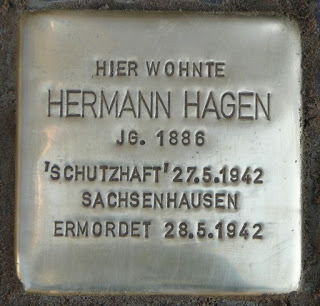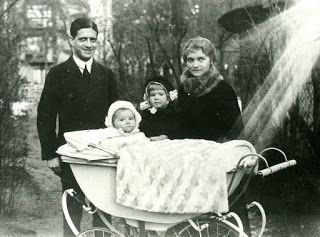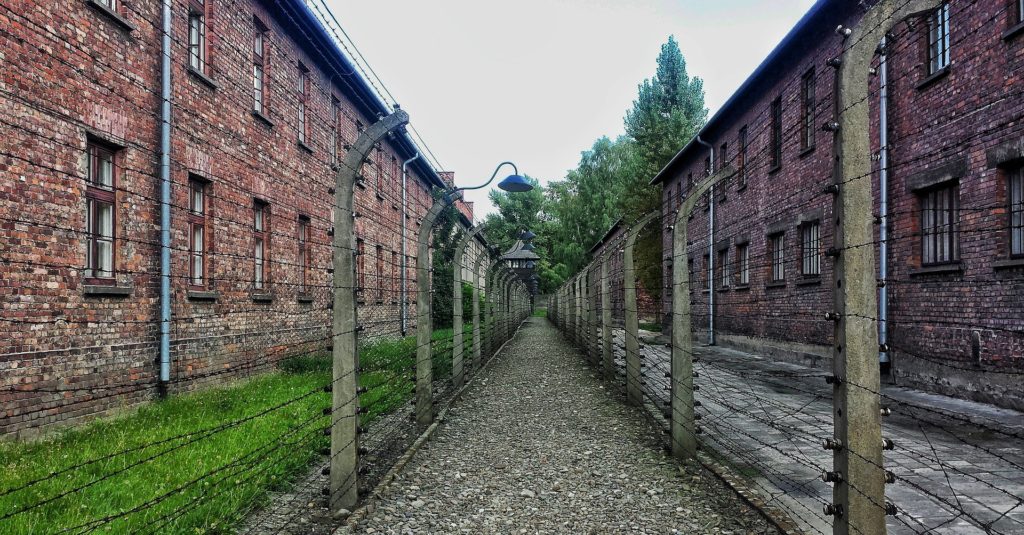
While tracing the stories of the victims of Jürgen Ziebell’s passport fraud in the late 1930s in Berlin, I often found myself sidetracked by the lives of siblings or other family members. Such was the case with Hermann Hagen.
Hermann was the older brother of Louis Georg Hagen who I have written about previously. Louis, having attempted to purchase a forged Finnish passport from Algoth Niska via Ziebell, found himself arrested by the Gestapo and imprisoned for several months. While Louis and his wife were fortunate enough to be able to escape via the Trans-Siberian Railway to Japan, and onwards to the USA, Hermann was not so fortunate. The 1939 German Minority Census showed that Hermann was deported to Sachsenhausen on 27 May 1942. What became of Hermann? As one might suspect, he perished in the Holocaust. What one might not expect is to learn that he was murdered the day after arriving at Sachsenhausen concentration camp.
Hermann Hagen received a Stolperstein in Berlin on 3 April 2009 in front of the entrance of Waitzstrasse 27 in Berlin, his last residence before being deported. The Bezirksamt Charlottenburg-Wilmersdorf site has a write-up of Hermann Hagen to accompany the stolperstein photograph (see above). I ran the write-up through Google Translate, tweaked the translation and added a few comments.
Early Life
Hermann Hagen was born as Hermann Levy on 19 February 1886 in Berlin. His father, the banker Carl Levy, had married Katharina Philippi and had four children with her: Margarethe, Hermann Carl, Louis [this is the Louis Georg Hagen mentioned above] and Clara [married Ernst David and both were also victims of Algoth Niska’s passport fraud but escaped to England]. Carl Levy came from a Cologne banking family who founded the Wiener Levy & Co bank with Richard Wiener in Berlin around 1880. Carl Levy’s brother Louis, who ran his father’s bank in Cologne, took over the name of his non-Jewish wife Anna Emma Hagen in 1893, which led to Carl adopting this surname as well. He, his wife and his children were allowed to do so by a police order of 16 June 1905. The bank was renamed Hagen & Co in 1921.
In 1894, when Hermann was eight years old, the family moved from Rauchstrasse to their own house at Derfflingerstrasse 12, both near the Berlin Tiergarten. Hermann grew up in this dignified quarter. In 1905 he passed the Abitur at the Royal French Gymnasium, then he studied, with interruptions, until 1910 at various universities – Munich, Freiburg, Berlin and Heidelberg – philosophy, economics and law. He did not graduate but, as he said, “strolled around”. At his father’s insistence, he served for a year with the 1st Guard Uhlan Regiment [light cavalry regiment armed with lances] in Potsdam.
The Disapproving Father

Hermann’s mother died of cancer in March 1907. Perhaps this was particularly stressful for him because his relationship with his father was strained. Carl Hagen was dissatisfied with his son’s academic achievements and his way of life, considered him “very nervous” and even had him examined at a mental hospital. This also meant that Hermann was declared unfit for war in 1914.
Around 1910, while in Heidelberg, Hermann met Hedwig Elisa Carolina Staadt from Essen (one year older than him) and moved in with her. This “offensive” relationship led to the university’s rector threatening expulsion and contributed to sanctions from Hermann’s father. Despite Carl’s disapproval, Hermann and Hedwig – who was not Jewish – moved into a shared apartment on Paul-Krause-Strasse in Nikolassee [northeast of Potsdam towards Berlin-Grunewald] in 1915. The couple had a daughter, Gerda Irene, born in April 1916 and Hermann and Hedwig married in October of that same year. Five more children followed: Hertha in 1917, Helga in 1918, Karl-Heinz in 1919, Hans in 1922 and Günther in 1924. Carl Hagen eventually accepted his son’s marriage and helped Hermann acquire his own villa at Prinz-Friedrich-Leopold-Straße 41, also in Nikolassee, where the family moved in 1919. In 1927 they moved to house number 21 on the same street.
Carl Hagen had already brought Hermann’s younger brother [Louis Georg Hagen] into the bank as a partner in 1912. Hermann, who had studied economics and was quite wealthy thanks to his parents, got a position as “bank archivist” there in 1921. In 1929, however, he was dismissed by his brother Louis, now in a leading position at the bank, because of the economic crisis. Berlin address books still listed Hermann as a bank archivist until 1936.
Incarcerated in a Psychiatric Facility
Hermann described his marriage to Hedwig as extremely happy, but it became difficult for him after she became seriously ill and was ultimately confined to a wheelchair. She died on 11 May 1935. The fact that Hermann had a non-Jewish girlfriend afterwards turned out to be his undoing. Since the Nuremberg race laws were now in force, he was arrested in March 1937 on “suspicion of racial disgrace”, taken to Plötzensee for pre-trial detention and sentenced to one and a half years imprisonment for this “offense” on 10 June 1937, which he had to serve in Brandenburg/Havel . A medical report by the prison doctor from Plötzensee, subsequently ordered by the Lichterfelde district court, came to the conclusion that he should be placed in a closed psychiatric department after his release from prison as “mentally confused”. This may have saved him from being transferred into “protective custody” in a concentration camp after being released from prison.
On the instructions of the political police, Hermann Hagen was admitted to the “sanatorium and nursing home” in Pankow on 26 September 1938, a psychiatric facility that was involved in the Nazi program for the murder of mentally ill people (“euthanasia”) from 1940 onwards . However, after more than a year of observation, he was judged to be “normal” and the transfer to an open ward was approved. At the request of his family and with the consent of the police, he was moved to the Waldhaus Clinic in Nikolassee on 18 December 1939. There, too, he was found to be “friendly, approachable, polite” and “completely inconspicuous”. On 6 August 6 1940 he was released “home”.
Executed by Injustice
Except “home” was no longer there. The villa had been sold, and so had the furnishings. We do not know exactly where Hermann Hagen lived immediately after his release, whether he was hiding or was assigned a room. In May 1942 he was living at Waitzstrasse 27, subletting from a widow named Anna Kann. On 18 May 1942, Herbert Baum’s anti-Nazi resistance group carried out an arson attack on the anti-Soviet propaganda exhibition “The Soviet Paradise”. In retaliation, the Nazi’s conducted a cruel “special action” (Sonderaktion) on 27/28 May during which 500 uninvolved Jews were arrested and deported to Sachsenhausen where 250 of them were shot immediately. Hermann Hagen was one of the unfortunate individuals who was arbitrarily murdered on 28 May 1942.
His landlady Anna (née Wittkowski) Kann was deported to Theresienstadt on 28 January 1943, sent onwards to Auschwitz on 16 May 1944 and murdered there.
Hermann’s Children
Hermann’s six children all survived: Helga and Günther fled to the USA, Hertha fled to London. Gerda (also called Greta) had married Alexander Catsch, who worked at the Kaiser Wilhelm Institute in Buch and was forced to go to the Soviet Union with other scientists for five years after the war. Karl-Heinz, who was imprisoned for several months for “decomposing military strength”, became editor-in-chief of B.Z., Berliner Morgenpost and Bild-Zeitung as well as of “Quick” and “Revue”.
The younger son, Hans Oliva-Hagen, born on 14 April 1922 was a journalist, writer and screenwriter who wrote under the pseudonyms Hans Oliva and John Ryder. Hans was active in the anti-fascist resistance and was incarcerated in Moabit prison from 1941 until the liberation by the Russians in 1945. In 1961 he was the winner of the GDR National Prize. From 1954 to 1959 he was married to actress and singer Eva-Maria Hagen (née Buchholz) with whom he had a daughter Nina Hagen who, like her mother, became an actress and singer.
Sources
The above is a translation of the write-up on Hermann Hagen from the Bezirksamt Charlottenburg-Wilmersdorf. The site credits the information and research to: Dr. Micaela Haas, with additional information from Nina Hagen, Hannah Starman and Helmut Lölhöffel. Additional Sources: Memorial Book. Federal Archives Koblenz, 2006; Files of the Berlin State Compensation Office; Berlin Memorial Book of the Jewish Victims of National Socialism 1995; Berlin address books; Berlin State Archives; Book of the Dead of Sachsenhausen Concentration Camp; Dieter Wunderlich: Biography of the Hagen family, 2010, (www.dieterwunderlich.de); Nina Hagen: Confessions. Munich 2010.
